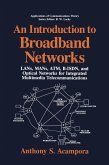The rapid development of optical fiber transmission technology has created the possibility for constructing digital networks that are as ubiquitous as the current voice network but which can carry video, voice, and data in massive qlJantities. How and when such networks will evolve, who will pay for them, and what new applications will use them is anyone's guess. There appears to be no doubt, however, that the trend in telecommunication networks is toward far greater transmission speeds and toward greater heterogeneity in the requirements of different applications. This book treats some of the central problems involved in these networks of the future. First, how does one switch data at speeds orders of magnitude faster than that of existing networks? This problem has roots in both classical switching for telephony and in switching for packet networks. There are a number of new twists here, however. The first is that the high speeds necessitate the use of highly parallel processing and place a high premium on computational simplicity. The second is that the required data speeds and allowable delays of different applications differ by many orders of magnitude. The third is that it might be desirable to support both point to point applications and also applications involving broadcast from one source to a large set of destinations.
Dieser Download kann aus rechtlichen Gründen nur mit Rechnungsadresse in A, B, BG, CY, CZ, D, DK, EW, E, FIN, F, GR, HR, H, IRL, I, LT, L, LR, M, NL, PL, P, R, S, SLO, SK ausgeliefert werden.









